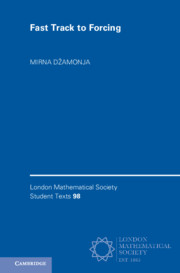Book contents
- Frontmatter
- Dedication
- Contents
- Preface
- Part I Let’s Be Independent
- 1 Introduction
- 2 Axiomatic Systems
- 3 Zermelo–Fraenkel Axioms and the Axiom of Choice
- 4 Well Orderings and Ordinals
- 5 Cardinals
- 6 Models and Independence
- 7 Some Class Models of ZFC
- 8 Forcing
- 9 Violating CH
- Part II What is New in Set Theory
- References
- Index
1 - Introduction
from Part I - Let’s Be Independent
Published online by Cambridge University Press: 28 September 2020
- Frontmatter
- Dedication
- Contents
- Preface
- Part I Let’s Be Independent
- 1 Introduction
- 2 Axiomatic Systems
- 3 Zermelo–Fraenkel Axioms and the Axiom of Choice
- 4 Well Orderings and Ordinals
- 5 Cardinals
- 6 Models and Independence
- 7 Some Class Models of ZFC
- 8 Forcing
- 9 Violating CH
- Part II What is New in Set Theory
- References
- Index
Summary
Set theory has a dual nature as a subject which is on the one hand foundational and on the other, mathematical. Its foundational background comes from the context in which after the Hilbert programme there came a search for axioms that would encapsulate the entire mathematics the way that, say, the axioms of Euclidean geometry in David Hilbert’s rendering of it, encapsulate that subject. The late nineteenth century was the time when many mathematical developments had made it clear that it was no longer possible to do mathematics without being aware of the foundations behind it, as paradoxes were starting to appear. Hence the Hilbert programme specifically set the goal of finding foundations for mathematics. Set theory has soon emerged as an acceptable, if not entirely perfect answer–as we shall explain later on. The subject of set theory is probably still best known for its connections with foundations.
- Type
- Chapter
- Information
- Fast Track to Forcing , pp. 3 - 4Publisher: Cambridge University PressPrint publication year: 2020



